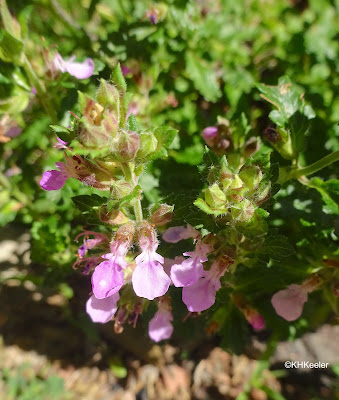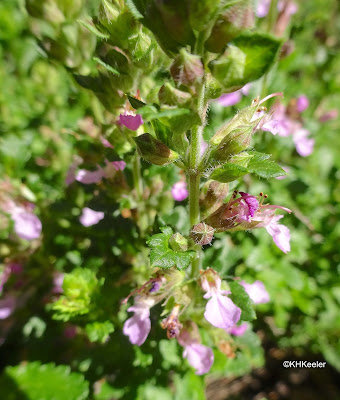Pennyroyal (Mentha pulegium) is a small European mint (mint family Lamiaceae) that was an important medicine for millennia. It was used to treat a number of illnesses but was sufficiently tricky to use that it has been replaced by other medicines and you rarely see it in North America, even in herb gardens.
 |
| European pennyroyal Mentha pulegium |
 |
| European pennyroyal flowers |
Related to peppermint, pennyroyal is in genus Mentha; Mentha was the traditional Roman name for mint. It was called puleium regia, royal fleabane for its efficacy repelling fleas, pulex being flea in Latin. Pennyroyal is how the English pronounced the Norman French puliol royal. The species epithet pulegium is another version of fleabane, so Mentha pulegium is fleabane mint. (Weirdly, pulex, is also the source for the color word puce, created by the French for a color that reminded them of the liquid when a flea was squished.)
Pennyroyal had common names in England such as run-by-the-ground, lurk-in-the-ditch, and puddinggrass. It has escaped on the Pacific Coast and in Pennsylvania, New Jersey, and Delaware. It is considered invasive in California. It is generally called European pennyroyal or pennyroyal across North America.
 |
| European pennyroyal Mentha pulegium close up |
There are American species called pennyroyal or false pennyroyal, genus Hedeoma, also in the mint family. When colonists arrived, they looked for pennyroyal and found Hedeoma. Like European pennyroyal, Hedeoma plants contain pulegone; it is as poisonous as European pennyroyal. It was used the same ways, from repelling fleas to settling the stomach to inducing menstruation. Hedeoma pulegioides, American pennyroyal or American false pennyroyal, in particular, from the eastern half of the United States, was widely used in place of European pennyroyal. Native Americans reported using and other species of Hedeoma to make tea, soup, as a spice, as insect repellent, to treat colds, headaches, toothaches, fevers and more, though I hope, very infrequently.
American false pennyroyal has 17 species scattered across North America; they would be fun to discover in the forest, with delicate purple flowers and fragrant leaves that smell rather like spearmint. (I don't have pictures of Hedeoma species check these: link).
Traditionally Europeans treated pennyroyal as an herb as well as a medicine, using it for flavoring. In particular there were stuffings for birds, puddings, and sausages with enough pennyroyal to have a very distinctive strong flavor. The pudding grass common name is based on these uses. Mrs. Grieve, writing in 1932 in England, says "it is now in disuse, as its taste and odour is too pronounced." (p. 625). And I would add, toxic.
 |
| Pennyroyal expanding beyond the flowerbed |
 |
| European pennyroyal Mentha pulegium |
In my yard, pennyroyal is an attractive, fragrant ground cover that attracts bees. Since it was once an important medicinal and herbal plant but is currently considered too poisonous to use, I can call it a retired herb, just enjoying the sunshine in my garden.
Comments and corrections welcome.
References
Cunningham, S. 1984. Cunningham's Encyclopedia of Magical Herbs. Llewellyn Publications. St. Paul, MN.
Durant, M. 1976. Who Named the Daisy? Who Named the Rose? Congdon and Weed, Inc. New York.
Greenaway, K. 1979. Kate Greenaway's Language of Flowers. Originally 1884. Avenel Publishers. New York.
Grieve, M. 1932. A Modern Herbal. Dover Reprint. Dover Publishing, New York.
Kleiner, D. E. 2018 Pennyroyal. Science Direct link Accessed 10/14/23.
Meyler's Side Effects of Drugs. 2016. Lamiaceae. 16th ed. link Accessed 10/14/23.
Moerman, D.E. 1998. Native American Ethnobotany.Timber Press. Portland OR. link
Oxford English Dictionary. 2023. “pudding grass, n.”<https://doi.org/10.1093/OED/2747320055>
Vickery, R. 1995. Oxford Dictionary of Plant-Lore. Oxford Paperbacks, London.
No comments:
Post a Comment